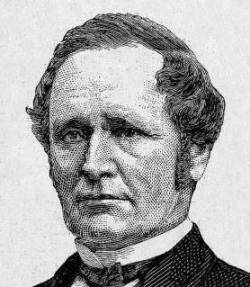|
|
|

|
| |
   |
|
| |
 |
|
|
| |
|
|
|
|
|
|
|
|

|
|
|
|
Born: September 7, 1819
|
|
Died: November 25, 1885
|
|
|
|
|
|
Complete HarpWeek Biography:
Thomas Hendricks was born in Zanesville, Ohio, to Jane Tompson Hendricks and
John Hendricks. The next year the family moved to an Indiana farm. After
attending local schools, young Hendricks entered Hanover College (Indiana),
where he became known for his debating skill, and graduated in 1841. He studied
law for a year under an Indiana judge, followed by law school in Chambersburg,
Pennsylvania. He was admitted to the bar and established a lucrative law
practice in Shelbyville, Indiana. In 1845, he married Eliza Morgan; their only
child died at the age of three.
In 1848 Hendricks, running as a Democrat, won a seat in Indiana's state
assembly; subsequently becoming chair of the banking committee. In 1850 he was
selected as a delegate to the state constitutional committee, where he argued
successfully for a ban on black migration to the state. The next year he was
elected to Congress and reelected in 1852 under the new state constitution. A
supporter of the Kansas-Nebraska Act and Stephen Douglas, Hendricks was defeated
for reelection in 1854 by a fusion candidate. He served as a land office
commissioner from 1855 to 1859. In 1860, he lost his bid to become Indiana's
governor to Republican Henry Lane. In 1863, however, the
Democratically-controlled state legislature elected Hendricks to the U. S.
Senate. He quickly became a leader of the Democratic opposition to the Lincoln
administration's policies on the draft, emancipation (including the 13th
Amendment), taxation, and the issuance of paper money ("greenbacks").
After the war, Hendricks endorsed President Andrew Johnson's lenient plan for
Reconstruction and opposed the Freedmen's Bureau Bill, Civil Rights bill, the
14th and 15th Amendments, and Johnson's impeachment. In 1868 he was one of
several contenders for the Democratic presidential nomination, but was defeated
by Horatio Seymour. Hendricks was nominated in the same year for governor of
Indiana, losing by a whisker-thin margin of 961 votes to Conrad Baker. For the
next several years Hendricks practiced law in Indianapolis, but in 1872 his
third nomination for the governorship was the charm. As the nation's first
Northern Democrat elected governor in the post-Civil War years, he accrued ample
political prominence within his party. When Democratic presidential nominee
Horace Greeley died shortly after the November 1872 election, 42 of his 62
electoral college votes were later cast for Hendricks.
In 1876, the Democrats selected Samuel Tilden of New York for president by an
overwhelming margin, then named Hendricks, who had placed a distant second in
the presidential tally, as the vice-presidential nominee. Although the ticket
was unsuccessful, Hendricks was again tapped by the Democrats as their vice
presidential candidate in 1884 to balance another New Yorker, Grover Cleveland.
In both 1876 and 1884, Hendricks balanced the presidential nominees
geographically and ideologically. Tilden and Cleveland were both "hard
money" supporters, while Hendricks (who had supported the
"hard-money" position in the 1860s) was a leading advocate of a
"soft-money" policy. Hendricks served as the nation's vice president for less than a year
when he died of a stroke on November 25, 1885, in his Indianapolis home.
Source consulted: Dictionary of American Biography; William A. DeGregorio,
The Complete Book of U.S. Presidents. |
| |
|
|
|
|
|
|
|
|
|
|
|
|
|
|
|


